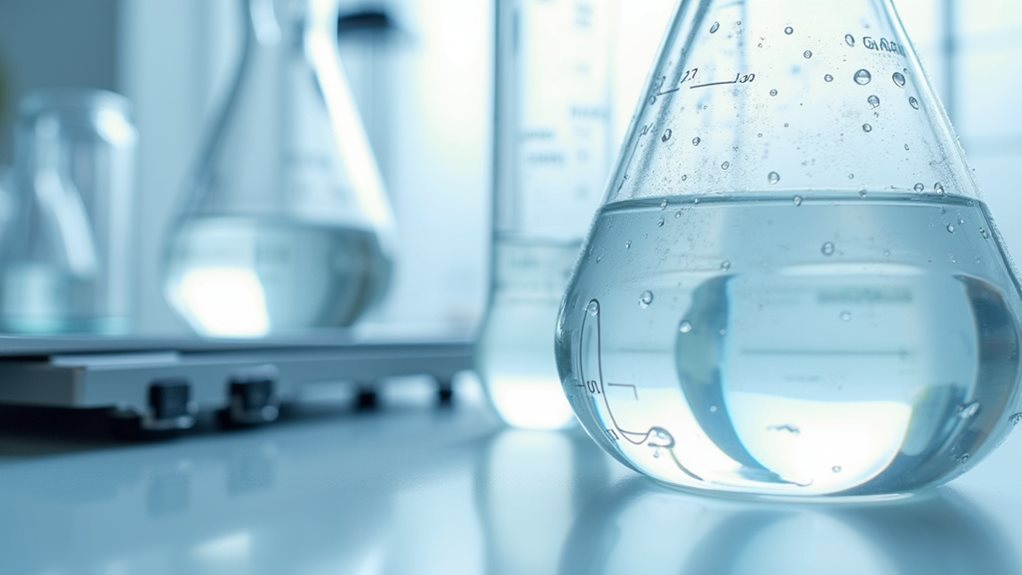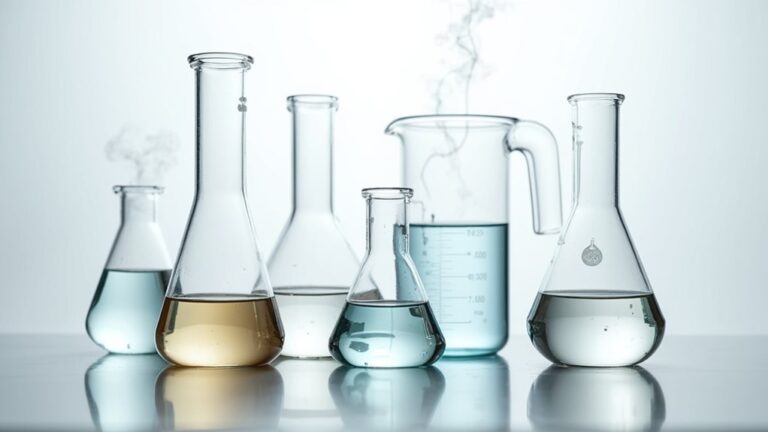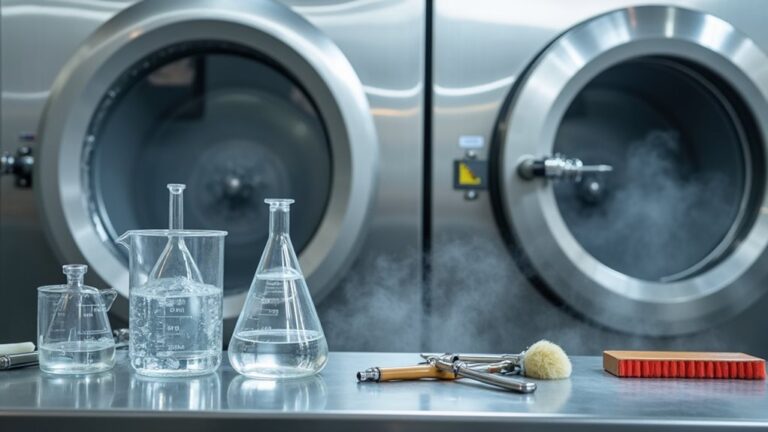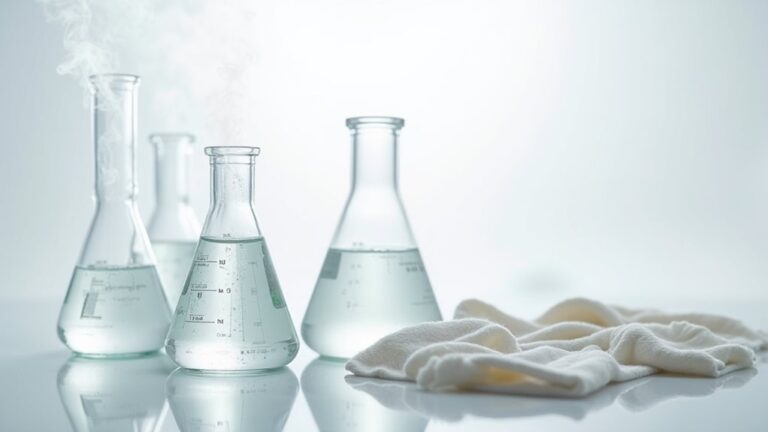You’ll need to identify your limiting reactant first when calculating grams of 1,2-dichloroethane from ethylene and chlorine gas. Convert your given masses to moles using molar masses (C₂H₄: 28.05 g/mol, Cl₂: 70.91 g/mol), then determine which reactant runs out first in the 1:1 ratio reaction. Multiply those limiting moles by the product’s molar mass (98.96 g/mol) for your theoretical yield. The complete calculation process reveals exactly how much dry-cleaning solvent you can produce.
Understanding the Chemical Reaction Between Ethylene and Chlorine
When I first encountered the reaction between ethylene and chlorine in my organic chemistry class, I remember thinking it looked deceptively simple on paper, but understanding the stoichiometry behind it completely changed how I approached chemical calculations.
You’ll notice that the balanced chemical equation C2H4 + Cl2 → C2H4Cl2 shows a perfect 1:1 molar ratio, which honestly made me feel pretty confident at first!
However, when you’re working with actual grams of reactants, things get trickier because you need to convert everything to moles using molar mass values.
Converting grams to moles using molar mass creates complexity that transforms seemingly straightforward stoichiometry problems into intricate calculations requiring careful attention to detail.
The real challenge comes when you discover that chlorine often becomes your limiting reactant, despite ethylene being present in larger quantities, which directly affects your theoretical yield of 1,2-dichloroethane.
While 1,2-dichloroethane serves as an excellent example for stoichiometry problems, it’s worth noting that the dry cleaning industry primarily relies on tetrachloroethylene as their solvent of choice due to its superior cleaning properties and non-flammable nature.
Calculating Molar Masses of Reactants and Products
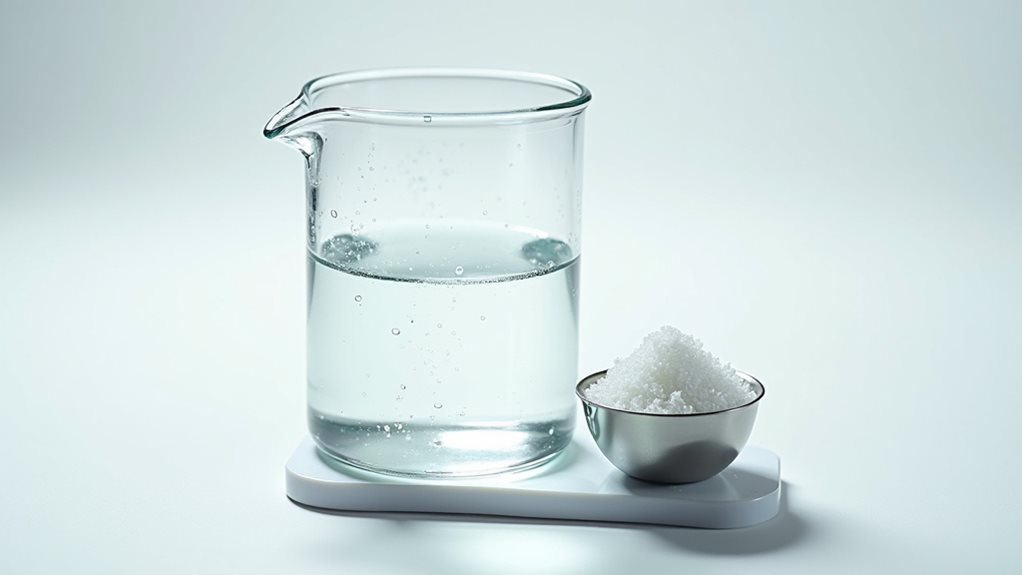
Before you can tackle any stoichiometry problem involving the production of 1,2-dichloroethane, you’ll need to master the art of calculating molar masses, which honestly became one of my favorite chemistry skills once I realized it’s basically just organized math with a periodic table twist!
Here’s your roadmap for calculating molar masses of reactants and products:
- Ethylene (C₂H₄): Add up carbon atoms (2 × 12.01) plus hydrogen atoms (4 × 1.008) to get approximately 28.05 g/mol
- Chlorine gas (Cl₂): Multiply chlorine’s atomic mass (35.45) by two atoms for 70.91 g/mol
- 1,2-dichloroethane (C₂H₄Cl₂): Combine all elements for 98.96 g/mol
These conversion factors help you identify your limiting reagent and perform accurate stoichiometric calculations.
Converting Given Masses to Moles for Stoichiometric Analysis
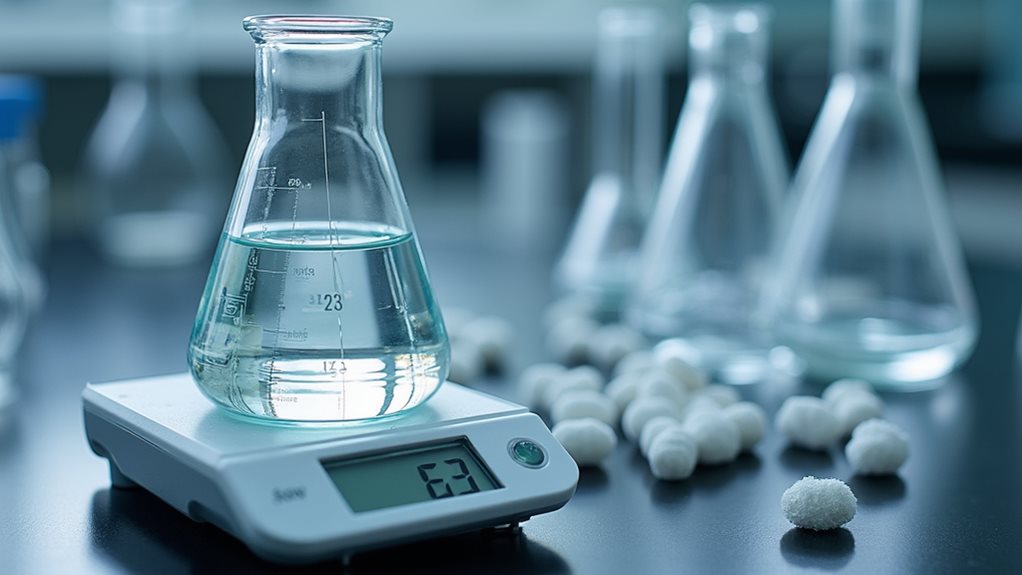
You’ll need to convert your given masses to moles before you can figure out which reactant runs out first, and trust me, I’ve learned this the hard way after countless chemistry labs where I skipped this step and wondered why my answers were completely wrong 😅.
Start by dividing your 15.4 g of ethylene by its molar mass of 28.05 g/mol to get approximately 0.55 mol, then do the same calculation for your 3.74 g of chlorine gas using 70.91 g/mol to find about 0.0527 mol.
These molar quantities become your roadmap for determining which reactant will limit your production of 1,2-dichloroethane, because chemistry doesn’t care about grams when it comes to counting molecules and their dance partners in reactions.
Mass to Moles Conversion
Since stoichiometry feels like solving a puzzle where every piece must fit perfectly, converting your given masses to moles becomes the crucial first step that’ll determine whether you succeed or struggle through the entire calculation.
When you’re working with ethylene and chlorine to produce 1,2-dichloroethane, you’ll need to transform those grams into moles using each substance’s molar mass.
Here’s your conversion roadmap:
- Divide the given mass by molar mass – For 15.4 g ethylene (28.05 g/mol), you’ll get 0.55 moles
- Apply the same process to chlorine – 3.74 g chlorine (70.91 g/mol) equals 0.0527 moles
- Compare mole quantities – This identifies your limiting reagent and determines theoretical yield
These conversions open the door to accurate stoichiometric calculations! 🔑
Calculating Molar Quantities
Converting masses to moles feels surprisingly straightforward once you understand the simple division that makes it all work, though I’ll admit I used to panic whenever I saw those molecular formulas staring back at me from chemistry homework.
You’ll calculate moles by dividing the given grams by each substance’s molar mass – for ethylene, that’s 28.05 g/mol, and for chlorine, it’s 70.91 g/mol.
Once you’ve determined the moles of both reactants, you can identify which one’s your limiting reagent in this 1:1 reaction. The limiting reagent controls how much 1,2-dichloroethane you’ll actually produce, making this step absolutely essential for accurate predictions.
Trust me, getting comfortable with these calculations now saves major headaches later! 😊
Determining Limiting Reactant
Why does identifying the limiting reactant matter so much when you’re trying to figure out how many grams of 1,2-dichloroethane you can actually make?
Think of it like baking cookies – you can’t make more than your smallest ingredient allows, regardless of how much flour you’ve got sitting around.
Here’s your step-by-step approach:
- Convert masses to moles using molar mass (ethylene: 28.05 g/mol, chlorine: 70.91 g/mol)
- Compare molar quantities from your chemical reaction (15.4 g ethylene = 0.55 mol vs. 3.74 g chlorine = 0.0527 mol)
- Identify the limiting reactant (chlorine wins this round 🏆)
Since chlorine’s your limiting reactant, it controls your theoretical yield completely.
The solubility properties won’t matter if you don’t have enough starting material!
Identifying the Limiting Reactant in the Synthesis
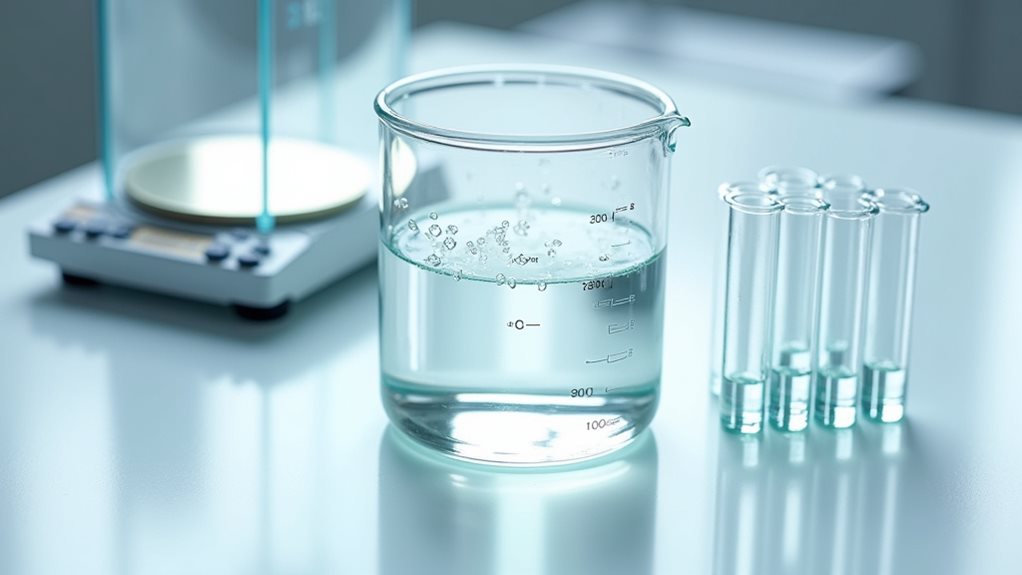
When you’re working through a synthesis problem like creating 1,2-dichloroethane, you’ll quickly discover that one reactant always runs out first, and that’s your limiting reactant—the chemical equivalent of running out of bread when making sandwiches, even though you’ve got plenty of peanut butter left.
In this synthesis, you’ve calculated that your 15.4 grams of ethylene gives you 0.55 moles, while your 3.74 grams of chlorine provides only 0.05 moles. Since the stoichiometry demands a 1:1 ratio, chlorine becomes your limiting reactant, determining your theoretical yield.
Think of it like this: you can’t make more 1,2-dichloroethane than your chlorine allows, regardless of how much ethylene you’ve got sitting around waiting for the party! 🧪
Determining Theoretical Yield of 1,2-Dichloroethane
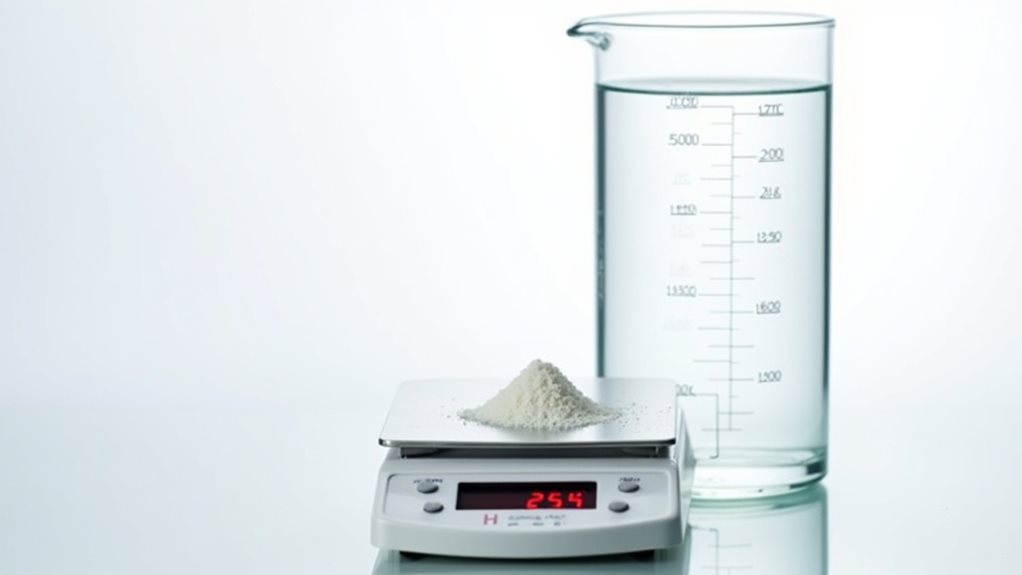
Now that you’ve identified chlorine as your limiting reagent, you’ll calculate the theoretical yield by using stoichiometry to determine how much 1,2-dichloroethane you can actually produce from those 0.0527 moles of Cl₂.
Since the reaction follows a 1:1 molar ratio, you’ll get the same number of moles of product as your limiting reactant, which means multiplying 0.0527 mol by the molar mass of C₂H₄Cl₂ (98.96 g/mol) gives you that magical theoretical yield number.
I remember getting excited about this step in chemistry class because it’s like solving a puzzle where all the pieces finally click together, showing you exactly 5.21 grams of product waiting at the finish line! 🧪
Identifying Limiting Reagent
One crucial step determines whether you’ll calculate the correct amount of 1,2-dichloroethane from your reaction, and it’s identifying which reactant runs out first – the limiting reagent.
Think of it like making sandwiches – you might’ve tons of bread but only five slices of turkey, so you’re limited to five sandwiches, no matter how much bread remains.
Here’s how you’ll identify your limiting reagent:
- Convert your masses to moles – 15.4 g ethylene gives you 0.55 mol, while 3.74 g chlorine yields only 0.05 mol
- Compare molar ratios – since this chemical reaction uses a 1:1 ratio, you need equal moles of each reactant
- Identify the smaller amount – chlorine’s your limiting reagent, controlling your theoretical yield
This foundation makes accurate stoichiometric calculations possible, guaranteeing reliable product yields every time! 🧪
Molar Mass Calculations
With your limiting reagent identified, you’ll transform those precious moles into actual grams through molar mass calculations – honestly, this part feels like magic every time I watch students’ faces light up when the numbers finally click!
Now that you’ve determined chlorine as your limiting reagent, you’re ready to calculate the theoretical yield of 1,2-dichloroethane. The stoichiometry shows that 0.0527 moles of chlorine will produce exactly 0.0527 moles of your product – it’s a beautiful one-to-one relationship!
Here’s where the molar mass becomes your best friend: multiply those 0.0527 moles by 1,2-dichloroethane’s molar mass of 98.96 g/mol, and voilà – you get approximately 5.21 grams.
This conversion from moles to grams completes your theoretical yield calculation! 📝
Stoichiometric Product Formation
How do you transform those calculated moles into the actual grams of product you can expect from your reaction?
Here’s where stoichiometry becomes your best friend, guiding you through the theoretical yield calculation like a trusted mentor walking you through each step.
With chlorine as your limiting reagent at 0.05 mol, you’ll produce exactly 0.05 mol of 1,2-dichloroethane – that’s the beauty of balanced equations!
Now comes the final conversion:
- Take your product moles (0.05 mol of 1,2-dichloroethane)
- Multiply by the molar mass (98.96 g/mol)
- Calculate your theoretical yield (4.948 grams)
This process transforms abstract moles into tangible grams you can actually measure.
While 1,2-dichloroethane can be produced in laboratory synthesis, it’s worth noting that perchloroethylene (PERC) has become the preferred solvent in commercial dry cleaning operations due to its superior cleaning properties and fabric safety profile.
Real-World Applications and Industrial Production Methods

Although you mightn’t realize it, 1,2-dichloroethane quietly powers much of our modern world, from the vinyl siding on your neighbor’s house to the plastic pipes running through your walls.
This remarkable solvent starts its progression through chlorination of ethylene, where industrial production facilities use continuous flow processes to maximize efficiency and meet global demand.
While you’ve probably encountered it in dry cleaning shops, where it works magic dissolving stubborn oils and greases from fabrics, its primary destiny lies in creating vinyl chloride for PVC manufacturing.
However, handling this chemical requires serious safety protocols since it’s classified as hazardous, posing genuine health risks through inhalation or ingestion.
Understanding these industrial processes helps you appreciate the complex chemistry behind everyday materials! 🧪

